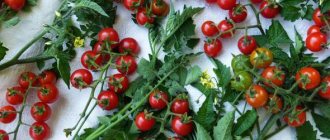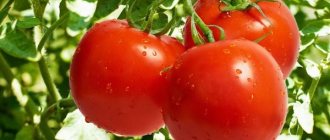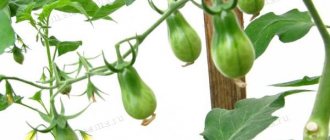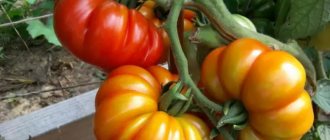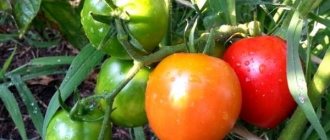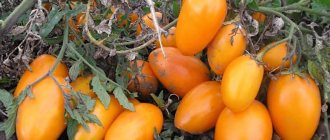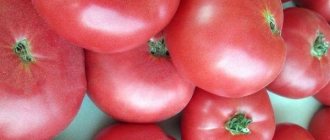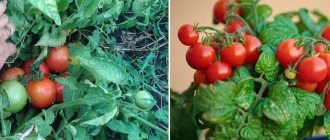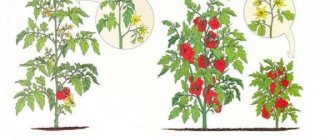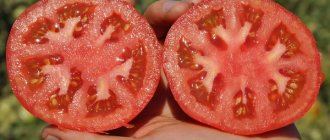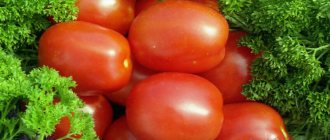Shade-tolerant tomatoes
We invite you to familiarize yourself with the most popular varieties in this category.
Balcony miracle
This variety is suitable for growing indoors or in greenhouses. It tolerates lack of light very well. Its vegetables weigh 70-100 g. You can harvest 2 kg of tomatoes from one plant.
Micron NK
This variety exists in two variations: with red and yellow tomatoes. This is a decorative variety of tomato, the height of the bush reaches 15 cm. The plant grows even without lighting.
Do you think that the most delicious tomatoes are indoor tomatoes?
Not really
Pinocchio
This variety makes it possible to grow compact bushes with small fruits. From one bush you can harvest 1.5 kg of tomatoes. Pinocchio is suitable for growing indoors and outdoors.
The most productive varieties of tomatoes for open ground in the middle zone
Features of growing tomatoes in open ground in the middle zone. As a rule, the climate in the middle zone forces the cultivation of only the most adapted types of crops. Therefore, when choosing a particular variety, you need to carefully read the available characteristics, especially with regard to tomatoes.
Also remember that it is difficult to grow tomatoes in poorly protected soil. Because they love warmth very much and require high-quality personal care. Breeders develop varieties that adapt well to any external conditions.
Many gardeners recommend installing various shelters. Form a special frame over the beds and then tighten it with high-quality material. In addition, seedlings can be planted in such beds almost two weeks earlier than in open areas.
It is advisable to grow by seedling method and choose varieties that ripen within 120 days. But if you decide to plant later species, they must have good disease resistance.
Tomatoes for open ground. Any planting in unprotected soil is a real risk for any gardener. And starting in August, many varieties begin to get sick. Therefore, you need to choose what you need very carefully.
Tall variety
Tall varieties are incredibly difficult to care for. Since they require mandatory techniques for execution: shaping, as well as garter. Moreover, gardeners have plenty to choose from.
- Barmaley. With proper care, tomato fruits most often grow up to 400 grams. And the bushes of plants are up to two meters in height. Therefore, you need to limit growth in order to get large vegetables. The fruits are incredibly strong, never crack, can last for a long time, and withstand any transportation well.
- Laura. If growth is not limited, the bushes can grow up to 2 meters. At all times, plants should be tied to supports and also pinched. The fruit often weighs 120 grams. The color is bright red with a standard taste. Can be stored for a very long time. And from 1 sq. meter it is easy to get up to 8 kg of tomatoes.
Medium-sized variety
This species is usually grown in order to get a good, rich harvest. Of course, it is much more difficult to care for it, but it is more effective.
- Supermodel. The variety ripens within 120 days after the first planting. The height of the bushes most often reaches up to 0.8 m. The type is determinant, therefore, the plant does not require pinching. Average height encourages the use of supports. A distinctive feature of this variety is that the fruits are very strong and never crack. And while performing the necessary agricultural techniques, there is no need to specially treat them for any diseases. From 1 square meter you can easily collect almost 9 kg of fruit. Each weight is 130 grams. Standard taste, without any special features.
- Kashtanka. The plant often reaches a height of 0.8 meters. Moreover, the fruits are red in color, small, with unsurpassed taste. Can be used for anything: canning, pickling, cutting vegetables and fresh salads. No special care required. They grow even in the most unfavorable natural conditions.
Low growing variety
Vegetable growers prefer these types and use frames when growing tomatoes. Plus they are easy to cover.
- Sanka. Bushes of this variety, as a rule, do not grow too tall, up to about 0.7 m. They ripen quickly, the period is 80 days. There is no need to pin or tie up. However, some people still remove the shoots, considering them unnecessary. At the same time, the plant easily tolerates cold, low lighting and lack of water. And if all these conditions are met, then from 1 sq. meter you can easily get up to 20 kg of ripe vegetables. The weight of each fruit reaches almost 200 grams. At the same time, plant care is minimal.
- Titanium. The variety is suitable for growing even on the balcony. Not very whimsical, bushes are often small in stature. Their height reaches up to 60 cm. They can also be planted both in open and closed ground. Weight is approximately 110 grams, which makes it possible to preserve the vegetable as a whole. And from one bush you can easily harvest up to 5 kg of tomatoes.
Early variety
Some summer residents cannot wait long for tomatoes to grow, and then early varieties come to their aid, which grow easily and quickly in the middle zone.
- Amur standard. This variety reaches a height of 0.5 meters. The fruits are small, red, weighing 150 grams. Excellent for preservation as a whole. There is no need to tie or pin. The yield is incredibly high. And if you follow all the agricultural techniques, then you can remove up to 5 kg of fruit from 1 plant.
- Aphrodite. This type has a lot of positive aspects, such as: High immunity; Versatility in use; Long storage period; Ovaries are formed under any climatic conditions, even the most unfavorable ones.
At the same time, the fruits are small, red, weighing up to 100 grams. And from 1 sq. meters often collects almost 16 kg. The height of all bushes is 0.7 meters. They are not too demanding in care, and there are no incredible features during cultivation.
Late variety
In the middle zone it is dangerous to grow late-ripening tomatoes. Because they cannot have time to ripen on the bushes themselves. However, some gardeners still decide to grow them.
- An amateur's dream. The variety has simply excellent taste characteristics. Acidity and sweetness combine well here. Ripe fruits are often used for any type of cooking, canning and processing. In addition, they are incredibly large and red. The bushes are very tall, up to 2 meters long. Therefore, throughout the entire care you need to shape them and constantly remove excess growth points.
- Saber. The most versatile type of tomato. The fruits are red in color, weighing 130 grams. The bushes grow up to 2 meters. Requires tying and shaping. From 1 sq. meter you can remove 8 kg.
Yield variety
A very important criterion when choosing a particular variety is the harvest. The more fruits are collected from one bush, the higher the popularity of this variety.
- Anastasia. Bushes of this variety grow up to 0.7 meters. In addition, they have good immunity, and do not need any worries. The weight of one fruit reaches 120 grams. And from 1 sq. meter you can easily collect up to 20 kg of ripe fruits.
- Rose. Bushes often reach 3 meters. Can be consumed after 110 days after planting. 1 tomato weighs up to 300 grams. The color is only bright red and good immunity. The demands on care are the highest: plants must be pinched and tied up.
Cherry tomatoes
There are many popular cherry varieties.
Biathlon
This is a hybrid variety that is great for growing outdoors. You can enjoy the first harvest after 90 days. The vegetables are red in color, round in shape and have a flat nose. One fruit weighs 80 g. The peculiarity of the variety is that it can be harvested continuously.
Danko
The height of the bush is 35 cm. And, although the plant is short, its fruits are large. One vegetable weighs 500 g. The variety can be used for growing in open ground, as it has a high yield. You can harvest up to 7 kg of tomatoes from one plant.
Dolka Far Eastern
This is an early cherry variety. Its fruits are of regular shape. They are slightly elongated and crimson in color. Vegetables are used to prepare fresh salad and for winter preservation.
For greenhouses
In central Russia, tomatoes can be grown not only on the street, but also in greenhouses. Before you start planting plants, you need to determine the best varieties of tomatoes that are ideal for greenhouse conditions.
White filling
When talking about early varieties of tomatoes, many gardeners think of White Filling. It was bred by domestic breeders relatively recently. White filling is grown in a greenhouse, but you can try growing it outside. Obvious advantages include its taste and productivity.
The determinate bush of the plant grows to only 50-60 cm, so caring for it is quite simple. There is no need to tie it with fabric strips to the supports or engage in pinning.
However, if a large number of fruits form on the bushes, then it is better to tie up the plant so that it does not break due to stress.
The fruits have a good bright red color. They have a classic round shape, so in appearance they differ little from other tomatoes. They are not very large and weigh about 80-100 grams. The pulp is dense, fleshy and quite sweet. These tomatoes are used for preparing vegetable dishes or creating preserves.
Sun
Gardeners who love productive tomato varieties quite often sow the Solnyshko variety in a greenhouse. From one such plant you can collect more than nine kilograms of fruit.
Some people don't know when to plant this variety of tomatoes to grow seedlings. It is recommended to sow seeds in the first weeks of March, so that by the end of spring the seedlings can be planted in the greenhouse.
The sun is distinguished by powerful tall bushes, which in ideal conditions can grow up to two meters. They require obligatory gartering to the columns and periodic removal of unnecessary stepsons. Also during the growing season you will have to do weeding, watering and fertilizing the soil. After all, only with proper care can you grow large tomatoes.
During cultivation, small fruits with a golden color are formed on the plants. Each of them weighs about 80 grams. They are covered with a thin and imperceptible skin, under which there is aromatic pulp. It is thanks to its juiciness that Solnyshka is perfect for swirling tomato juice.
Dobrun
Dobrun is ideal for the Middle Volga region and its surrounding areas. That is why it is very popular among vegetable growers in this region. It is very important to decide when to sow tomatoes in order to get a lot of harvest. Dobrun is planted for seedlings already in March, so that young seedlings can be planted in mid-May.
See also
Characteristics and description of the tomato variety Yablonka Rossii, its yieldRead
Tall bushes reach 150-200 cm in height.
It is recommended to grow them only in greenhouses, since street temperatures can negatively affect fruiting and growth.
On each cluster of the bush, about seven fruits weighing 150-200 grams are formed. They have a standard round shape and a bright, red color. The pulp of Dobrunya is especially juicy and dense. The fruits are most often used in cooking to create vegetable salads or winter preservation.
Altaechka
Created by domestic breeders for planting in central Russia. These tomatoes are known for their heat-loving nature and ability to tolerate high summer temperatures. It is recommended to grow Altaechka only in greenhouses, since in such conditions it will form new fruits before the first frost.
The bushes of the plant are determinate and grow up to one meter. They need gartering and removal of stepsons. A distinctive feature of Altaechka is the shape of its fruits. The fact is that it is similar to the shape of chicken eggs. The tomatoes are covered with thin red skin with a raspberry tint. They do not weigh very much - 100-150 grams. The advantages of the fruit include their keeping quality and good transportability.
Early tomatoes
You can also familiarize yourself with early ripening varieties.
Alpatieva 905 A
The height of the bush is 45 cm, the weight of one fruit is 50-75 g. The variety is early ripening, since the vegetables ripen already on the 105th day. The taste is excellent, so tomatoes can be used for canning and eating fresh.
Ground Gribovsky 1180
An early-ripening variety, the height of which is 52 cm. It has a high yield, round fruits, and weighs 90 g. The variety is distinguished by its resistance to frost. The disadvantage of the plant remains its damage to late blight and bacterial rot.
Newbie
This is an early-ripening and young variety that allows you to get tomatoes weighing 80 g. The plant is resistant to brown spot and root-knot nematode. The fruits are not subject to mechanical damage and tolerate transportation well.
Transplanting tomato seedlings into open ground
In early May I transfer the seedlings to the plot.
That's where I feed it with what I have - bird droppings, mullein, mineral fertilizers, and pour humus on top of the boxes above the sides. And my seedlings stand, gaining strength, and at this time I prepare the bed, holes and earthen mixture, which consists of humus, ash and sand. I start planting seedlings after May 15, and also in two rows. Between two bushes in a row I place a peg for a garter. When planting, I add potassium permanganate to the water.
After planting the seedlings, I cover the entire bed from above with acrylic No. 42. It holds well on the pegs, I sprinkle earth in the corners, and it’s easy to open when leaving. At the beginning of June I remove the shelter completely. The tomatoes grow well, bloom, and the super early ones are already set.
The best tomato hybrids
There are many varieties that are profitable to grow in central Russia.
Red Arrow
This is a productive type of tomato that does not require pinching. The fruits ripen on the 110th day. Vegetables have a regular oval shape, each weighs 130 g. The variety is resistant to disease and tolerates shade well.
City dweller F1
This is an ornamental tomato that is distinguished by early ripening and high yield. Its fruits weigh 30 g and have excellent taste. For early ripening, it is necessary to pinch the side shoots.
Paradise F1
An early ripening species, since you can enjoy ripe vegetables 95-100 days after germination. The height of the bush is 1.5 m, the fruits weigh 100-120 g. They have a round shape, and at the place where the stalk is attached there is a green spot.
Harvest and storage
Depending on the purpose of further use of the fruits, they can be collected at different degrees of ripeness, given that unripe tomatoes can ripen during storage.
Table: degree of ripening of tomatoes depending on the purpose of use
| Maturity level | Characteristic signs | Ripening period | Application |
| Immature | Fruits are firm, green | Not ripened, not eaten | |
| Dairy | The skin is light, the flesh is pinkish or yellow | 20-30 days | For salting, pickling and long-term fresh storage |
| Blanzhevaya | Fruit color is brown, may begin to turn red | 7-10 days | |
| Biological | Rich color characteristic of the variety | Fresh consumption, canning, short-term storage | |
Methods of planting and growing tomatoes in the middle zone are widely known to gardeners in its regions. By following simple rules, it is not difficult to grow tomatoes of any variety you like on your plot.
- Author: Pyotr Vladimirovich Sadovnikov
Hello! My name is Pyotr Vladimirovich. I am 63 years old. By education, he is a mechanical engineer. Rate this article:
- 5
- 4
- 3
- 2
- 1
(18 votes, average: 4.3 out of 5)
Share with your friends!
Yellow tomatoes
If you are interested in yellow tomatoes, you can check out the following options.
Yellow giant
This is a mid-season tomato, as harvesting occurs on days 110-122. The height of the bush is 1.2-1.8 m, the variety is indeterminate. The vegetables are bright yellow and have a round shape. The plant is suitable for growing indoors. Needs pinching and gartering. Vegetables have a sweet taste and aroma. There is resistance to cracking.
Altai orange
This is a tall plant whose fruit harvest occurs on day 110-115. In the middle zone, grow Altai orange in a greenhouse. Since the plant is tall, it needs to be tied up and pinched. The vegetables are large, flat-round in shape, they have tender and fleshy pulp.
Barrel of honey
This is a mid-season indeterminate variety with yellow tomatoes. When growing, Barrel of Honey requires pinching and gartering. Tomatoes weigh 400 g, they have a flat-round shape, the taste is sweet and aromatic.
Care
The main stages of caring for tomatoes are the same for both open ground and greenhouses.
Watering
There is one general rule for tomatoes of all varieties, which applies in any region. According to this rule, tomatoes should be watered abundantly at the time of transplanting seedlings into the ground, and then stop watering for 3-4 weeks. As a result, the roots of the tomatoes will actively grow and develop in search of water. After this time, watering is resumed at intervals of 7-10 days (in extreme heat, 5-7 days). In this case, water is supplied into grooves 10-15 cm deep, formed at a distance of 15-20 cm from the stems on both sides of the row. You need to know that tomatoes are watered rarely, but abundantly. Their roots grow deeply (in some varieties more than one meter), so the soil can dry out to a depth of 5-7 cm. But waterlogging and stagnation of water, which can often be observed in the northern regions of the middle zone, should not be allowed. Drip irrigation systems can be used to water tomatoes, which significantly reduces the labor intensity of the process.
Drip irrigation systems can be used to water tomatoes, which significantly reduces the labor intensity of the process.
Growing tomatoes without watering
In the middle zone, where summer rains are frequent, it is quite possible to do without watering. This is permissible on moisture-intensive soils (chernozems, loams). If the roots of tomatoes are well developed, then they can independently extract moisture from deep layers. Watering may be necessary in cases where the intervals between rainfalls exceed 1 month and the weather is hot, dry. With this method of cultivation, it is necessary to mulch the soil to prevent moisture evaporation and drying out of the soil. For this you can use:
- straw;
- hay;
- peat (not sour);
- sunflower husk;
- humus, etc.
I have been using this method for three years - the tomato bushes are powerful and strong, the foliage is juicy and rich in color. When the fruits grow to medium size, I begin to water the plants once a week.
Top dressing
Early ripening determinate varieties of tomatoes do not require additional fertilizing if the soil is properly prepared. This is explained by the fact that the fruits are harvested quite early and the plants do not have time to use up the nutrition provided before planting. But mid-season and late-ripening tomatoes need to be fertilized periodically. The first time this is done 3-4 weeks after planting, simultaneously with the first watering. At this time, plants need nitrogen fertilizers to ensure the growth of green mass and stem growth. Organic infusions (mullein, chicken droppings, freshly cut grass) that you can prepare yourself are best suited for this. The next feeding, which is carried out after 2 weeks, should contain phosphorus and potassium (for example, potassium monophosphate at a rate of 10-20 g/m2). Subsequently, fertilizing is repeated at intervals of 2-3 weeks, alternating nitrogen with potassium-phosphorus.
Shaping, pinching, trimming, garter
Tall determinate and all indeterminate varieties of tomatoes require gartering of stems, shaping of bushes and removal of shoots.
To garter tomatoes, trellises or crossbars with hanging cords are installed in advance. Tall tomatoes are usually formed with 1-3 stems:
- to form into 1 stem, simply remove all the stepsons formed during the growth process once a week;
- to get the second stem, leave a stepson growing from the axil of the leaf located under the first flower raceme;
- For the third stem, one more of the basal stepsons is additionally left.
Tall tomatoes usually form 1-3 stems
For all tomatoes, the lower leaves located up to the first flower cluster are gradually cut out in order to improve ventilation. Do this early in the morning so that the wounds dry out by evening, removing no more than one or two leaves from the bush at a time.
Features of caring for tomatoes in a greenhouse
In addition to the listed stages of care in the greenhouse, it is necessary to monitor temperature, humidity and illumination, and, if necessary, adjust them using the methods described above.
Tomatoes are the sweetest
There are many options for sweet tomato varieties.
Honey fireworks
This variety has a sweet taste and bright appearance. The fruits are used to make juice, salad and dessert. When grown in a greenhouse, the plant grows to a height of 180 cm. Harvesting occurs after 120 days. From 1 m2 you can get 7 kg of ripe tomatoes. Their weight is 300-450 g, they are round and flattened on top. The color is yellow with red stripes and spots. The peculiarity of the variety is that the harvested crop is prone to long-term storage.
Pink honey
A sweet variety whose bush will grow up to 70 cm. The vegetables have thin skins, which is why they cannot withstand transportation. One fruit weighs 1.5 kg. The variety can grow on any land, but it has one drawback - susceptibility to diseases.
Gold
A mid-season variety that is unpretentious. From this bush you can harvest 2.5 kg of tomatoes. They have a pleasant taste and aroma. The bush is low, formed into 2 stems, so pinching is not required. The tomato weighs 40 g.
Self-pollinating
They will prove indispensable in cold summer conditions without sun, when insects do not perform their natural function - pollinating, spreading pollen to plants.
Ural
Gina
Mid-ripening, determinate, large-fruited, the first cluster is laid after 8 leaves, the rest after 1-2, does not require pinching or tying, with bright red, flattened, juicy, sweetish fruits weighing 200-300 g. resistant to diseases, requires treatment for pests.
Mystery
Ultra-early ripening, determinate, high-yielding, with the first cluster at the 5th leaf, sets clusters of 5-6 fruits, does not produce stepsons, with bright red, round, fleshy fruits weighing 70-80 grams (up to 22 kg). Very unpretentious. Resistant to diseases.
Video about the tomato variety Riddle:
Typhoon F1
Early, high-yielding, indeterminate, forming clusters of 7-8 ovaries, with small red fruits containing a high amount of ascorbic acid.
Kostroma F1
Highly productive, unpretentious, disease resistant.
Siberia
Intuition
Medium early, productive, indeterminate, with obligatory pinching and tying, with red, round fruits of 80-120 g (5 kg).
Orange cream
Medium-early, productive, indeterminate (up to 110 cm), needs pinching and tying, with yellow fruits of 60 grams, which are collected in clusters of 7-8 pieces. Cold resistant.
Central Russia
Red icicle
Early ripening, tall, with obligatory tying and pinching, forms clusters with fruits from 10 to 15 pieces on each.
Tomatoes for open ground
We present to your attention the most delicious tomatoes for open ground.
Ivan Kupala
A raceme variety that is used for growing in open ground. The fruits are red-crimson, pear-shaped, weigh 140 g. They are resistant to heat and have high yields. The bushes grow up to 150 cm. They need sunlight, so you will have to remove unnecessary leaves to speed up the ripening of vegetables.
Banana Red
This variety is designed for growing outdoors. The fruits are red, elongated, their length is 12 cm. The vegetable weighs 100 g. The variety is mid-season, has a high yield and is resistant to fungal diseases. From one bush you can harvest up to 2.8 kg of ripe tomatoes. The plant needs pinching and pinching. The harvested crop endures long transportation.
Banana
A tomato that can be grown in a greenhouse or outdoors. The vegetable is pepper-shaped, red in color and has excellent taste. The average weight of a tomato is 120 g. The variety is mid-early, medium-sized, needs shaping and staking. The fruits are resistant to cracking. When grown indoors, the bush grows up to 1.5 m.
Growing seedlings
The main method of planting tomatoes in the middle zone is seedlings. You can grow seedlings at home on a windowsill or in a winter greenhouse.
Terms and rules for sowing seeds for seedlings
When determining the timing of sowing tomato seeds for seedlings, it is assumed that for most varieties, their age before transplantation should be 55-60 days. Therefore, to grow tomatoes indoors, seeds are planted in the middle - end of February, and for open ground - at the end of February - early March.
Seed preparation
This stage consists of the following simple steps:
- Calibration - rejection of light, empty seeds. To do this, they are placed in slightly salted water for 20-30 minutes, after which the seeds that have sunk to the bottom are left for planting, and those that have floated are thrown away.
- Disinfection is the treatment of seeds against fungal diseases by immersing them in a pink solution of potassium permanganate for 10-15 minutes, followed by rinsing with water.
- Hardening - keeping seeds wrapped in damp gauze in the refrigerator (2-3 days).
Growing tomatoes in open ground (eastern Ukraine), I mainly use seeds collected with my own hands. And since I try to prevent fungal diseases on my site, I usually sow seeds for seedlings without preparation. And I should note that I did not observe any problems with germination or diseases.
Sowing
Since seedlings need picking for better formation and development of roots, the seeds are initially sown in containers or boxes filled with nutrient soil. You can prepare it yourself in the fall by mixing the following components:
- turf soil - 2 parts;
- humus - 1 part;
- peat - 1 part;
- sand - 1 part.
You can also buy ready-made industrial soil.
You can buy ready-made soil for tomato seedlings.
Before sowing, the soil is moistened and grooves 1-1.5 cm deep are formed on its surface at intervals of 4-5 cm. Prepared seeds are placed in these grooves in increments of 2-3 cm, after which they are covered with peat. The containers are covered with film or glass until germination.
I have been growing tomato seedlings in improvised greenhouses for several years now. After the renovation, I still have several glazed window frames. Based on their size, at the beginning of April I dig several holes 30-40 cm deep. I lay nutrient soil at the bottom in a layer of 10-15 cm, into which I sow my seeds. I form rollers 10-15 cm high along the perimeter of the pits and lay glazed frames on them. After the emergence of seedlings on warm days, I open the beds slightly for ventilation and water the seedlings with warm water. In the second half of May, I plant the tomatoes in a permanent place without picking. Quite pleased with the results.
Seedling care
After germination, the containers are placed in a well-lit place, for example, on a windowsill. If there is a lack of lighting, artificial light sources are used, providing a daylight hours of 14-16 hours.
Dive
When two or three true leaves are formed, the seedlings are planted in individual containers, for example, plastic or peat glasses with a volume of 0.3-0.5 liters. The bottom of the glasses must have drainage holes to remove excess moisture. In this case, the central root is cut off by 20-30%, and the plant is buried in the soil up to the cotyledon leaves.
When 2–3 true leaves are formed, the seedlings are planted in individual containers
Watering
Seedlings need to be watered regularly, maintaining an optimal level of soil moisture. At the same time, it should not dry out deeper than 0.5-1 cm, and at the same time, moisture should not stagnate.
It is convenient to water tomato seedlings using a sprayer
Feeding
2 weeks after picking, the plants should be fed with organic fertilizers, for example, potassium humate. Feeding is repeated once more every 10-15 days.
Standard tomatoes without pinching
You can learn more about tomatoes that do not require pinching.
Hyperbola
Harvesting when growing this variety is possible after 105 days. Hyperbola is suitable for growing indoors. The bush grows up to 130 cm, so it needs to be tied up. The plant produces egg-shaped fruits. They have excellent taste and red color. One vegetable weighs 90 g.
Golden stream
The fruits on the plant ripen early. They are orange in color and ellipsoidal in shape. One vegetable weighs 100 g. The variety is distinguished by its high yield and resistance to temperature changes. Also, Golden Stream is resistant to pathogenic microorganisms.
El Dorado
The height of the bush is 70 cm, while it is quite compact. One vegetable weighs 250 g and has a regular oval shape. The tomato skin has a pleasant lemon tint. The harvested crop has excellent taste and aroma.
High-yielding varieties and hybrids of tomatoes
Productivity more than 6 kg per 1 sq.m.
Ural
Yamal
Ultra-early, with rapid ripening of red, flat-round fruits, 70-120 g (up to 12 kg), with good keeping quality. Not afraid of temperature changes, unpretentious.
Video about the Yamal tomato variety:
Polar early ripening
Early, the first cluster is tied after the 7th leaf, subsequent ones - after every 2nd, with red, round fruits 60-160 g (up to 7 kg). Resistant to temperature changes and cold snaps.
Sovereign F1
Early ripening, forms more than 4 clusters, with bright red, round, dense, 150-180 g (17 kg), no need to form a stem.
Olya F1
Early, 3 clusters are formed in the internodes, each with 7 fruits, with red, round fruits with weak ribbing, 150-200 g. (10-15 kg), resistant to cold and shade, to a complex of diseases, including root-knot nematode.
Video about the tomato variety Olya F1:
Lelya F1
Medium-early, low-growing, compact, up to 11 tomatoes in a cluster, with red, flat-round fruits, 100-150 g (15-18 kg), does not shoot.
Lyubasha F1
Ultra-early, up to 1 m, the stem is formed into 2-3 trunks, with rich red, round fruits, 120-200 g, necessarily requires tying and pinching.
Siberia
Nikola
Early-mid-ripening, determinate (65 cm), high-yielding, with smooth ripening of fruits, with red, round, sour fruits, 80-200 g (8 kg). Resistant to unfavorable conditions, grows on universal soils. It does not take steps, there is no need to form a bush. Susceptible to late blight, bacterial black spot and blossom end rot.
Demidov
High-yielding, mid-ripening, determinate (60-64 cm), standard, with pink, round, slightly ribbed fruits, 80-120 g (10 -12 kg). Sets fruit well under unfavorable climatic conditions. Resistant to diseases, with a lack of moisture it is affected by blossom end rot.
Sanka
Ultra-early ripening, low-growing (50-60 cm), with red, round, slightly ribbed fruits, 80 g (10-12 kg). High resistance to cold, shade tolerance. Immunity to all diseases.
Video about the tomato variety Sanka:
Juggler F1
High-yielding, early, determinate (60-70 cm), inflorescence contains 5-6 fruits, with bright red, flat-round, fleshy fruits, 200-300 g (12-14 kg). Drought-resistant, tolerates low temperatures well. Doesn't take steps. It is rarely exposed to disease, but if necessary, it must be protected from late blight and Alternaria by spraying with the drug “Ordan”. They are affected by spider mites, aphids, and thrips.
Central Russia
Brawler
Early ripening, determinate (45 cm), bushy, not elongated, high yield, fruit set, with red, cylindrical fruits of 70-80 g (7 kg). Doesn't produce side shoots - doesn't shoot or tie up. Tolerates sudden changes in temperature. Resistant to tobacco mosaic, needs to be treated against late blight.
Gourmand
Early ripening, determinate (60 cm), the stem does not need to be formed, the first cluster is formed above the 7th leaf, the next after 1-2, with crimson, round fruits of 100-120 g (8 kg). Does not require pinching or pinching, you can grow 7-9 pieces per 1 sq.m. Tolerates drought. Immunity from rot, manages to ripen before late blight appears.
Alyonka F1
Ultra-early, indeterminate (up to 1 m), unpretentious, with scarlet, spherical fruits up to 200 g (15 kg), unpretentious, disease-resistant.
Early ripening tomatoes
You can also get acquainted with tomatoes, which have a very fast ripening period.
Pickling miracle
Universal variety, determinate. It is used for growing in open and closed ground. The bushes grow to a height of 50 cm. The variety is resistant to viral and fungal diseases. The vegetables are bright red and weigh 90 g. The harvest can be harvested in 80-90 days.
Sanka
This is an ultra-early ripening type of tomato that produces ripe fruits already on 73-75 days. The variety is resistant to low temperatures, diseases and pests. It does not need lighting, so short daylight hours are enough for vegetables to ripen.
Room surprise
This is a high-yielding variety, low-growing, determinate. It can even be grown at home. Plant height is 50 cm, fruit weight is 25 g. They have juicy pulp with sourness. From one bush you can get 2 kg of ripe vegetables.
Tall
Indeterminate varieties. Indeterminate - tall, requiring pinching, bush formation and pinching, but producing many clusters with a large number of fruits.
Ural
Waterfall
Early ripening, with bright yellow, ovoid fruits, universal in use. Requires pinching, tying, pinching, and is prone to various diseases.
Stellate sturgeon
Mid-early, up to 1.5 m, high-yielding, with red, bright crimson, heart-shaped, medium-density fruits, 500-1500 g (up to 5 kg), good keeping quality and transportability. Requires tying and constant pinching. The bush needs to be formed into 2 shoots. Resistant to diseases.
Video about the Sevruga tomato variety:
President 2 F1
Early ripening, high-yielding, with unlimited growth, 1.5 - 2 m, formed in 1-2 trunks, with the first cluster above the 7-8 leaf, with orange-red, heavy, round, slightly flattened salad fruits, 340-360 g ( 5-7 kg per bush). There are few stepsons, but they need to be removed in a timely manner; they require support. High resistance to disease, you should be wary of the greenhouse whitefly.
Bobcat F1
Up to 120 cm, medium early, with small fruits up to 140 g (up to 5-6 kg), with good keeping quality and transportability. Be sure to stepchildren so that there are more lateral sprouts. Resistant to anthracosis of leaves and fruits, not subject to Fusarium wilt.
Siberia
Budenovka
Mid-early, up to 120-150 cm, requires pinching the top, forms 6-8 clusters with 6 fruits, the first is formed over 9-11 leaves, with pink, heart-shaped, slightly ribbed, up to 300 g (up to 7 kg from one bush). Be sure to tie it up. High resistance to bad weather conditions. Resistant to late blight and powdery mildew.
Video about the Budenovka tomato variety:
Wonder of the earth
High-yielding, early-mid-ripening, with red-pink heart-shaped or elongated, sweet, dessert-tasting fruits up to 1000 g (4-5 kg per bush). Quickly adapts to changes in nature and is drought-resistant.
Caspar F1
Medium early, with red, spherical fruits, 150 g each. Necessarily pinching, gartering, and shaping the bush into 1 stem. Resistant, but requires prevention against late blight.
Central Russia
Keg F1
Medium early, forms 4-5 clusters, each with 6 ovaries, with bright red, cylindrical fruits of 90 g, excellent lightness and transportability. Prone to overgrowing with stepchildren (stepchildren are necessary). Drought resistant.
Heat-resistant tomatoes
If there is even the slightest chance that there will be heat during the tomato growing period, then you should learn more about heat-resistant varieties.
Ramses F1
This variety must be grown indoors. The growing season is 110 days. The fruits are round in shape, slightly pointed at the bottom. They are dense and red when ripe. One tomato weighs 140 g. From 1 m2 you can get 13 kg of ripe tomatoes. The variety is resistant to pathogenic microorganisms.
Portland F1
This is a mid-early hybrid variety whose bush height is 1.5 m. The growing season is 110 days. The variety is characterized by high yield and smooth ripening of vegetables. From one bush you can get up to 5 kg of tomatoes. The fruits are round and weigh 110 g. The variety is distinguished by its ability to form the ovary well during sudden temperature changes. The formation of a bush is carried out in one stem. The plant is resistant to pathogenic microflora.
Verlioka plus F1
The variety is early ripening and high-yielding. Differs in friendly maturation. The height of the bush is 180 cm, it needs tying up. Formation occurs in 1 stem. There will be up to 10 ovaries on one hand.
The tomatoes weigh 130 g and are large. They have a thick skin, which makes the vegetables resistant to cracking. The variety is resistant to short-term drought and sudden temperature changes.
The choice of tomatoes for growing in central Russia is quite wide. Here every gardener will be able to find the most successful and high-yielding one for himself. In this case, you need to take into account such points as fruit weight, plant height, disease resistance and taste.
You can also watch a video where an experienced gardener will tell you which varieties of tomatoes are suitable for central Russia.
Determinate tomatoes up to 0.6 m high
The group includes super-determinate and low-growing varieties that require minimal care. Such bushes do not require mandatory pinching; they independently slow down their development when several brushes are formed. Removing side shoots is recommended for the formation of more massive tomatoes and faster ripening of the crop. It is convenient to carry out pinching once a season, pinching the side shoots under the first brush “on a stump”.
Round and heart-shaped weighing 70–240 g
RED
Leader of the Redskins F1
The super-early hybrid from St. Petersburg Agro will ripen already 80 days after germination. It is possible to grow without seedlings. The tomatoes are scarlet, without a green spot near the stalk. The shape of the fruit is round-flat, with slight ribbing in the upper part; the weight ranges from 120 to 150 g. Particularly attractive is the unpretentiousness and cold resistance of this hybrid variety. From 10 sq. m of plantings, 60-100 kg of tomatoes are harvested.
F1 debut
This hybrid, originally from Holland, has been on the Russian State Register since 2008. It attracts attention with its early ripening of rather large, dense tomatoes (180-230 g). At the end of the third month of the growing season, the tomatoes on the lower clusters begin to turn red - round, slightly ribbed. The bushes do not grow too high (0.5 m), but powerful, with long-lasting returns. The yield exceeds 90 kg from a ten-meter bed. The hybrid exhibits resistance to Alternaria, Verticillium, and Fusarium wilt.
Jumpact F1
This early ripening variety was included in the Russian State Register in 2009. The seeds are supplied by the creator of the hybrid - the European branch of Japanese. Powerful plants grow to a height of just over half a meter. Fruit size is 100-150 g. Spherical tomatoes have a rich red color, dessert taste, and a pulp density unusual for early varieties. Tomatoes do not crack, do not rot, and are successfully stored and transported.
Massive returns are achieved due to the stability of the ovary. The hybrid can withstand sudden temperature changes, heat and cold snaps. Plants are genetically resistant to root nematodes and a complex of infections - fusarium, bacterial spot, verticillium, and viruses. The variety responds positively to the use of complex fertilizers.
Coconut Beach (Coconut Beach)
It takes 110 days from germination to the appearance of the first red tomatoes. The bushes grow quickly, spreading out in breadth. Abundant fruiting is observed without pinching. Tomatoes set even in extreme weather conditions. The fruit branch bears 5-6 round-oval tomatoes measuring 120-200 g. The scarlet pulp has a sweetish taste and a very dense consistency. The fruits are not suitable for juice production, but are suitable for processing into tomato paste or adjika, and are used for whole-fruit canning.
Sturdy F1
The early maturing hybrid from agro has been on the State Register since 1999, without losing its relevance in the 21st century. Particularly noteworthy are the friendly ripening and stable ovary in conditions of extreme temperatures - both high and low. The brushes begin to grow from the fifth internode; then fruit branches follow through 1-2 leaves. Tomatoes begin to turn red 85-95 days after germination, reaching a weight of 170-200 g. The shape of the tomatoes is spherical, slightly flattened at the top; ribbing is insignificant. The pulp is quite dense, harmonious taste. The advantages of the hybrid include transportability and visual attractiveness of marketable fruits.
The bushes grow compact, but need staking, otherwise they lie down under the weight of the crop and dense foliage. From 10 sq. m harvest up to 1 quintal of vegetables. The hybrid has unique tolerance to a wide range of diseases - many viruses, verticillium, fusarium, bacterial spot, as well as root-knot nematodes.
Sanka
The popular ultra-early tomato was bred by the famous breeder Yu. I. Pantchev from Transnistria; it was entered into the State Register of Russia in 2003. The tomatoes are not prone to cracking and will ripen happily from the 80th day of the growing season. Round, slightly ribbed tomatoes weigh from 70 to 100 g. When ripened, the fruits become bright red, without a green spot in the attachment zone. Each brush develops 4-5 ovaries, which grow even in cloudy and cool weather. The variety is valued for its short stature (0.6 m) and unpretentiousness; does not require shaping. The average yield is estimated at 60 kg from a ten-meter ridge.
The Snow Queen
An early ripening tomato selected by L.A. Myazina was registered in the State Register in 2008. The collection of red tomatoes begins on the 85th day of the growing season. The variety is famous for its rapid ripening, tolerance to cold snaps and soil drought. On low-growing (45 cm), weakly leafy bushes, tomatoes 80-150 g in size are formed. The shape of the tomatoes is round-flat, with small ribs visible at the top. One plant produces up to 3 kg of dessert fruits.
PINK AND Crimson
Demidov
The popular variety ripens 3 months after sowing. Strong standard-type stems reach a height of 0.6 m. The bushes are tolerant of cold weather; tomatoes weighing 80-120 g are poured consistently even with sudden temperature changes. The bright pink tomatoes are spherical in shape, meaty and delicious. From 10 sq. m per season, 50 kg of smooth, standard fruits are harvested. Unripe tomatoes ripen well. The variety needs uniform moisture in the root zone: with excess moisture, the fruits crack, and in drought they suffer from blossom end rot.
Lyana pink F1
Transnistrian breeder Yu. I. Panchev offers a pink-fruited version of the Lyana variety, popular in the Middle Zone. Hybrid Liana rosea F1 forms massive bushes half a meter in height. The first inflorescence appears above the fifth leaf. Ripening of raspberry-pink fruits begins 82 days after the start of growth. Each cluster carries 5-7 smooth, spherical tomatoes weighing 80 g. The tomatoes are transportable; Tasting score is high. The yield potential is estimated at 80-100 kg per 10 square meters. m. The hybrid is not affected by Alternaria and viral mosaic.
Nyusha
An unpretentious mid-early (105 days) variety that can be grown without pinching. The height of the main stem is 0.6 m; the internodes are close together, which ensures the compactness of the plant and abundant yield - more than 3 kg of tomatoes from each plant. 6-8 fruits are tied in a brush. When poured, the tomatoes acquire a mass of 150 g, a dessert taste and a sparkling pink color. The variety does not suffer from tobacco mosaic.
Pink Bush F1
The modern (in the State Register since 2014) hybrid combines early ripening with excellent density of round fruits. Low but powerful bushes have short internodes and are characterized by high productivity. Large pearl-pink fruits up to 200 g in size have a pleasant sweetish taste. Hybrid plants are not damaged by fusarium and verticillium.
Superclub
The newest variety, bred in Siberia and included in the State Register in 2015, quickly gained popularity among gardeners in the Middle Zone. The thick and strong standard stem does not stretch during the seedling period, and over the entire season does not grow above 40 cm. The root system is also compact, making dense planting possible. In terms of ripening time, the tomato belongs to the mid-early category: the fruits are ready for harvest on the hundredth day of the growing season. Round raspberry-pink tomatoes measuring 140-240 g are hidden under thick foliage, which does not prevent them from ripening in open ground, producing up to 100 kg of vegetables per 10 sq. m. The variety can be grown without shaping, but to obtain early and large fruits, it is recommended to plant the fruit up to the first cluster.
YELLOW-ORANGE
Golden heart
The variety selected by Yu. I. Panchev (Transnistria) has been on the Russian State Register since 2001. The tomato is famous for its very early ripening (on the 80th day of the growing season) and its excellent yield for an early ripening tomato - 70 kg from a ten-meter bed. Plants grow up to 0.6 m. Attractive heart-shaped fruits are golden-orange in color. The weight of tomatoes ranges from 80 to 100 g. The dense, high-vitamin pulp has a sour taste and rich aroma. This unpretentious variety can be grown without pinching.
Extended
RED
Fighter (Brawler)
A popular, reliable early-ripening variety is valued for its unpretentiousness and stable yield over the years. The tomato was bred in Siberia and included in the State Register in 2000. It is recommended for cultivation in all agricultural regions of Russia. In seedlings, seedlings do not stretch. The plants form compact bushes of the standard variety, no more than 35-45 cm in height. Internodes are short. The variety can be grown without shaping or pinched only up to the first cluster. The top branches and produces an abundant ovary.
Flowering begins at the sixth internode. Tomato ripening occurs at the end of the third month of the growing season. Fighter-Buyan gives away the harvest quickly and amicably: it almost completely ripens on the vine. Tomatoes are elongated oval or cylindrical, sometimes with a small “spout”. There are also pear-shaped fruits. The average weight of tomatoes is estimated at 70-90 g, the maximum (in the first bunch) reaches 180 g. The density of the pulp is average, the taste is excellent. The bushes do not suffer from viral tobacco mosaic and are resistant to drought and cold snaps. Due to their early maturity, plants have time to harvest before fungal infections spread.
See also: Soil for tomatoes - preparing nutritious soil with your own hands
Gurdon F1
The hybrid was created by Dutch breeders to replace the previously popular Caspar F1. It has been in the Russian State Register since 2011. Plantings are not affected by nematodes, fusarium and verticillium. In the mid-early period (92-95 days), oblong-cylindrical tomatoes weighing 70-95 g ripen on compact bushes. Seasonal returns from 10 sq. m is more than 70 kg. Smooth tomatoes with strong flesh are suitable for whole-fruit pickling and pickling. The light, rich red fruits retain their excellent presentation for a long time for market sales.
Lady fingers
The popular pickling variety with a “speaking” name has many options. As a rule, bushes do not grow above half a meter and do not require mandatory pinching. On low plants, numerous clusters of beautiful fruits are formed, shaped like an even cylinder with a small “spout”. The weight of tomatoes is 50-100 g; the skin and pulp are dense, rich red. The ripening period is characterized as mid-early (95-110 days).
Duel plus F1
The early-ripening Dutch hybrid has been registered in the State Register of Russia since 2007. It is valued for its high productivity and smooth ripening of evenly-aligned fruits. Plants are not affected by Fusarium and Verticillium wilt. Compact, medium-leafed bushes bear numerous ovaries, which quickly fill, acquiring a rounded-elongated shape and a weight of 80 to 120 g. The covering tissues are red, shiny, and strong. Transportability of ripe fruits is good. The pulp is dense, but not rough. The purpose of tomatoes is salad and canning.
Gigolo
The original mid-early variety from St. Petersburg amazes the imagination not only with the bizarre shape of the “sausage” fruits, but also with its high yield. A standard bush, the height of which does not exceed 45 cm, is abundantly hung with fruit clusters. Each inflorescence produces 5-6 ovaries. The length of the tomato reaches a size of 160 mm and a diameter of 30-40 mm. On average, tomatoes weigh 135 g. The internal consistency is dense, not watery. Fruits within the same cluster turn red at the same time. Compact plants do not need pinching.
Moscow pear
This is a new version of the popular old variety Grushovka. Compact bushes half a meter high produce beautiful pear-shaped tomatoes ranging in size from 100 to 200 g. The inflorescence bears 5-6 flowers. The ripening period is average (115-120 days from the beginning of the growing season). The tomatoes are fleshy, have few seeds, and have a dessert taste. The raspberry-pink color of the fruit looks appetizing. It is recommended to plant plants up to the first cluster. Plants have the genetic ability to adapt, grow and bear fruit normally in any weather conditions. From a ten-meter ridge you can get 30-40 kg of tomatoes.
Shuttle
The time-tested variety bred by VNIISSOK (All-Union Institute of Seed Growing) remains popular in the 21st century. The tomato is valued for its ultra-earliness (82 days), long-term yield, compactness of the standard bush (45 cm), and unpretentiousness. The plants do not need shaping, steadily growing numerous red tomatoes measuring about 60 g. The shape of the tomatoes is plum-shaped, with a beautiful “spout”. The dense pulp provides the excellent taste of pickled tomatoes. Maximum yield from 10 sq. m can reach 80 kg.
YELLOW
Buyan yellow
The variety was obtained in Siberia and entered into the State Register in 2007. Buyan yellow is rightfully classified as a small group of ultra-early tomatoes in open ground, including in the conditions of the Middle Zone. The tomato is characterized by uniform ripening of the standing crop. Seedlings are not prone to elongation. Compact standard bushes grow to a height of 45 cm. Heart-shaped fruits ranging in size from 95 to 155 g ripen in the lower clusters; in the upper inflorescences, oval and pear-shaped tomatoes of 55-85 g are formed. As the skin ripens, it acquires a golden-yellow color. A slight dessert sourness is clearly felt in the taste; the pulp is slightly watery (“jelly”), but has few seeds. The variety is resistant to negative environmental factors; It bears fruit consistently in any summer, despite cloudy weather, drought, temperature changes and cold snaps.
Large-fruited
Nobleman
Registered in the State Register in 2005, this Siberian variety received a State patent as an outstanding achievement of selection. On a powerful but low (50-60 cm) bush, large fruits are formed: in the first cluster - up to 800 g, in subsequent clusters - from 130 to 300 g. The ripening period is characterized as medium (115 days), with pinching it shifts to mid-early (105 days). days). It is recommended to normalize branched inflorescences, leaving no more than 4 ovaries in each. The fruits have a beautiful heart-shaped shape and an attractive crimson color. The pulp is sweet, sugary, moderately juicy, with few seeds. Productivity reaches 80 kg per 10 square meters. m.
Canopus
This mid-season tomato of Siberian selection is loved by gardeners in the Middle Zone for its large-fruited and disease-resistant plants in open ground conditions. The variety was patented in 1998, and in 2000 included in the State Register. The height of the bush does not exceed 60 cm; foliage is average. The elongated, heart-shaped fruits of the first cluster reach a weight of 300-400 g even in the absence of pinching. Cylindrical tomatoes of the upper clusters weigh 100-120 g. From 1 sq. m get more than 3 kg of fleshy raspberry-red tomatoes. Plants have genetic tolerance to tobacco mosaic and demonstrate resistance to soil drought, fungal and bacterial infections.
Kolyvan F1
The modern beef tomato from St. Petersburg yields its harvest early (95-100 days from germination). A compact bush with close internodes produces the first inflorescence after 5-6 leaves. Tomatoes weigh 250-350 g. They are round-flat, ribbed, pearl-pink, without a greenish area in the area where the stalk is attached. The pulp is dense, dessert taste. The hybrid is not affected by root and crown rot.
Red elephant
The new breeding beef tomato was registered in the State Register in 2018. The seeds are produced in the “Russian Bogatyr” series. With a low bush (0.5 m) and mid-early (105 days) ripening, the variety pleases with unexpectedly large (300-350 g) fruits. They are a salad classic: rounded, flat, deep red. The pulp is low-seeded, sugary, with a balanced taste.
Pink stele (stella)
This wonderful tomato was bred by Siberian breeders and included in the State Register in 2007. The authors of the variety, V.N. Dederko and T.V. Postnikova, received a State Patent for an outstanding breeding achievement. Many Russian gardeners know the tomato under its old name - Super Pepper.
The seedlings do not stretch. In open ground, the height of standard stems does not exceed half a meter. Internodes are close together; inflorescences grow frequently - through a leaf - and each bears 5-7 ovaries. The variety can be grown without standardization, but pinching up to the first cluster helps to enlarge the fruits. The first picked tomatoes are pulled out to 300-350 g; The average weight for all harvests is from 120 to 200 g. The fruits have an elongated heart-shaped shape and an attractive pink-raspberry color. Ripe tomatoes do not last long. The pulp is low-seeded, sugary, tender, sweet. The fruits set and fill in any weather. The yield of the crop (over 60 kg per 10 sq. m) is stable over the years.
